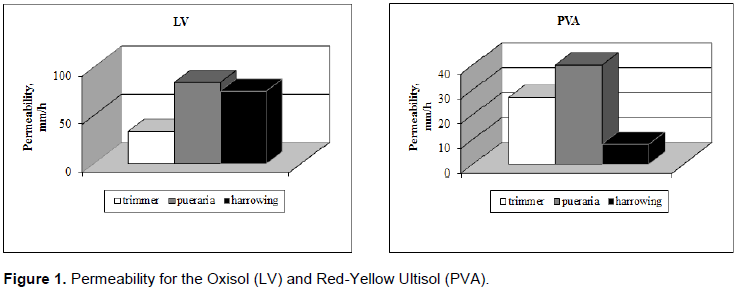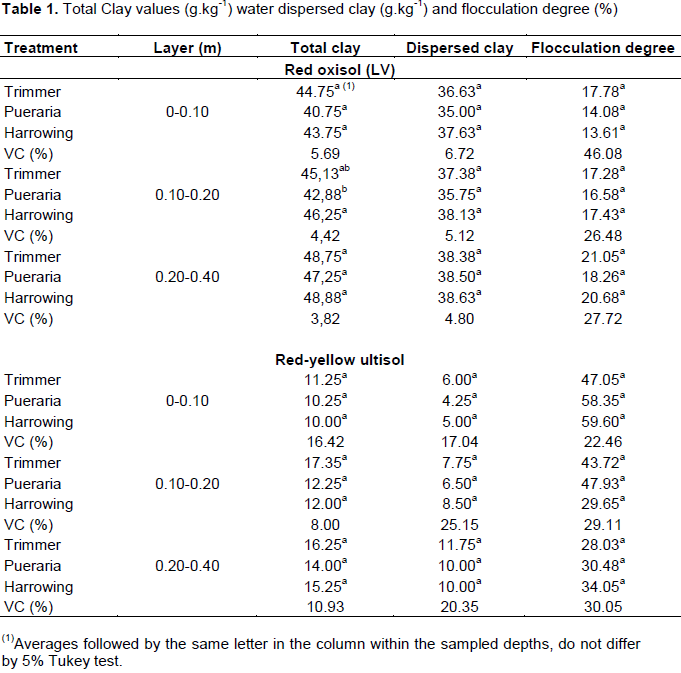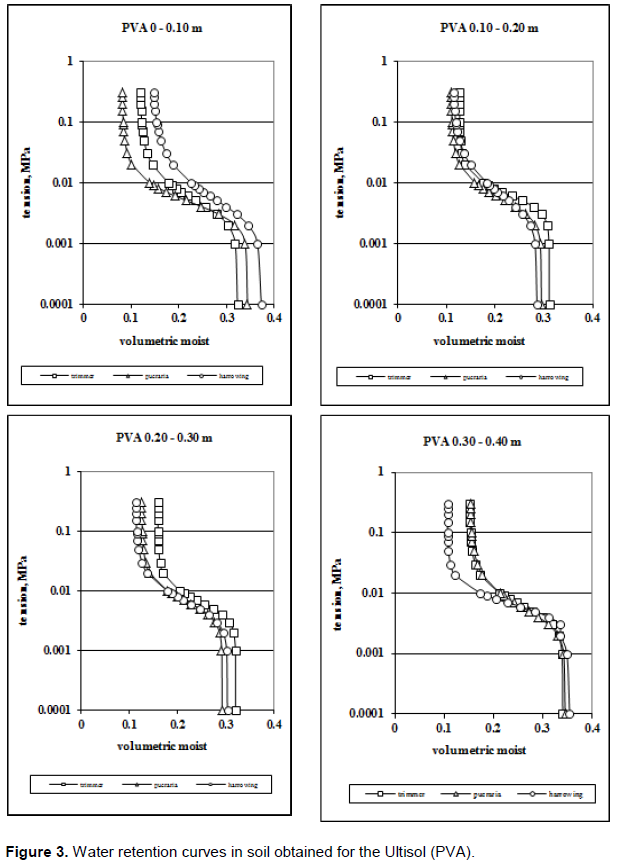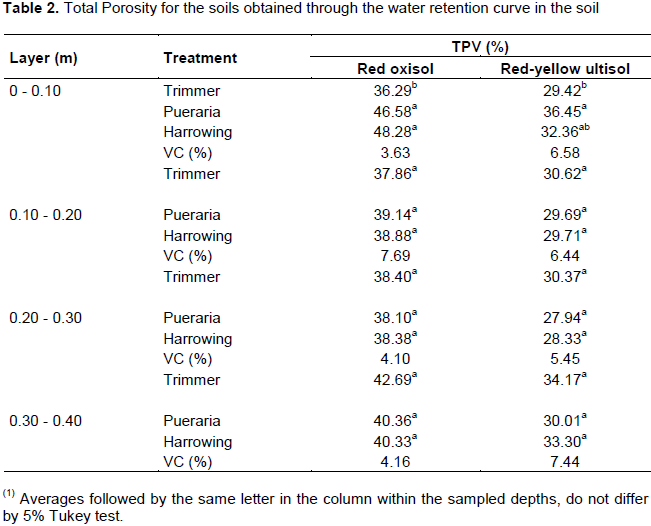ABSTRACT
São Paulo’s western plateau is a privileged region for rubber tree plantation, since it does not present favourable conditions for the development of plant disease. However, the soil in that region is still scarcely studied. This study has the objective of evaluating the effect of management practices applied between the lines of rubber trees (Hevea brasiliensis) in physic-hydric attributes of a red oxisol and red-yellow ultisol, in the city of Jaboticabal-SP, in random blocks with four repetitions. The following treatments were applied between the lines: harrowing, green manure application with Pueraria phaseoloides and trimmer. The quantified data were: soil permeability, clay content, disperse clay, flocculation degree, water retention curve and total porosity, for four soil layers (0-0.10; 0.10-0.20; 0.20-0.30; and 0.30-0.40 m). The studied soils presented differences regarding water permeability for the different treatments. Higher gravimetric humidity for lower tensions in both soils was observed. Green manure with pueraria favors increase in total porosity in the studied soils, contributing for increase in total porosity, humidity and permeability.
Key words: Oxisol, Ultisol, soil management, soil conservation.
São Paulo’s Plateou, in southwestern Brazil, is a region with around 14 million hectares with potential to rubber tree plantation for its climate characteristics, which ensure fast tree growth and are not favourable for
Microcyclus ulei, responsible for the South American leaf blight, and for its light and deep soils (IAC, 2016). However, the knowledge on which management practices cause less alterations in the physical properties is still very little and it is key for a better plantation development and soil conservation. The conventional management used in the region is harrowing, with some recom-mendations for trimmer and green manuring (Centurion et al., 2005). However, the management techniques have great influence in soils attributes and species development. Ribon et al. (2003), when studying Oxisols and Ultisols in the area, have observed that the management with trimmer favours the increase in soils density and reduce the soil’s macro porosity, eventually causing harm to tree development. On the other hand, Centurion et al. (2005), when studying the influence of types of management in the soil’s chemical properties and rubber tree nutritional state and development, observed that trimmer is important for the soil-plant system. Centurion et al. (1995) performed a study on rubber tree development in soils from São Paulo’s plateau (Oxisols and Ultisols) and have verified that those have not presented limitations in physical properties, effective depth, texture and internal drainage in this crop’s development.
Ultisols limitations refer to their high erosion susceptibility but they can, however, be corrected through the use of terraces, leveling and maintenance of the vegetation cover during the rain period. Regarding Oxisols, limitations were related to chemical properties, suggesting that this type of soils’ management, especially for cultivation of deep root systems as deep as those in rubber trees, must include liming and phosphate covering with deep incorporation and gypsum, in order to neutralize toxic aluminum for soils low in nutrients. Proper soil management is critical for maintaining or altering its original physical properties at the bare minimum, especially those which are affected by compaction, such as infiltration, water retention and porosity. However, there are few information regarding physical properties from the soil in productivity of perennial cultivation. Ribon et al. (2014) have observed that green manure cultivation between cultivation lines (Havea brasiliensis) enables better distribution of bigger aggregates in the layer of 0-0.10 m, when compared to management with trimmers for Oxisols in São Paulo state. The authors have also observed that intensive soil movement reduces aggregate size for Oxisols and Ultisols. This structure modification and soil aggregation reflects directly in the soils’ infiltration and water retention, inferring that the adopted management method may influence on this characteristics for rubber tree cultivation soils.
According to Bastos et al. (2005), aggregate formation and soil structure is established by soil colloids flocculation. Thereby, clay quantity, clay dispersed in water and flocculation degree are important attributes to be quantified after the adoption of different management methods in a soil given their influence on all other physical and physic-hydric soil attributes. Marchão et al. (2007) have observed that different soil managements (direct and conventional planting) have great control over alterations in soil’s water retention curve (WRC) which reflects soils structural state and soil’s capacity in retaining water either through porous system (water retained in higher tensions) or through clay surface (water retained in lower tensions). In this context, the present study has the objective to evaluate the effect of management practices applied between rubber tree (Hevea brasiliensis) lines in the soil’s water retention curve, porosity, permeability and flocculation degree in a Red Oxisol and in a Red-Yellow Ultisols in São Paulo’s plateau.
In this study, two experiments were conducted, one in clayey in texture Red Oxisol (LV), from the city of Jaboticabal-SP (Lat. 21°S 15’W; long. 48°S 18’W; alt. 595 m) and the other in medium/sandy texture Red-Yellow Ultisols (PVA) from Tabapuã-SP (Lat. 20°S 57’W; long. 49°S 03’W; alt. 545 m.), both with rubber trees planted in 1992 (Embrapa, 2013). Both locations present Cwa climate, with rainy summer and dry winter, as shown in the Thornthwaite and Mather (1955). The experiment was installed in random blocks, with four repetitions, with an experimental parcel with 28 plants (four lines with seven plants), where the ten central plants were considered as the useful parcel. The other farming practices, such as sprouting, pest control and others were performed as appropriate. The fertilizing was performed according to the soil analysis, pursuant to Raij; Quaggio (1983).The following management methods were applied between rubber tree lines: harrowing, Pueraria phaseoloides (tropical Kudzu) and trimming. These managements have been utilized since the cultivation implementation in 1992, with plantation from of PB235 clone. Soil permeability is measured by the saturated soil’s hydraulic conductivity, and was performed in the superficial layer (0.20m) through hydraulic charges of 0.05 and 0.10 m with Guelph permeameter, pursuant to Reynolds and Elrick, 1985).
Total clay content was determined in the layers of 0-0.10 m; 0.10-0.20 m; and 0.20-0.40 m, using NaOH as chemical spreaders, with slow agitation (16 h), though pipette method (Embrapa, 2011). Disperse clay had distilled water as a spreader. From the values of total and disperse clay, the flocculation degree was calculated. In the soils, the water retention curve and total porosity were obtained in the layers: 0-0.10, 0.10-0.20, 0.20-0.30 and 0.30-0.40 m. Water retention, in undeformed samples (54.3 cm³), was determined in ceramic plate extractors, through drying, according to Richards (1965), in the tensions of: 0.006; 0.01; 0.033; 0.06; 0.1; 0.3 MPa. According to Reichardt (1988), the use of higher potentials, which correspond to field capacity, occurs more frequently in soils submitted to drainage in field conditions and, moreover, they make laboratory determinations simpler. From the soils water retention curves adjusted according to GENUCHTEN, total porosity was obtained, considering the total porosity obtained by the difference in saturated soil mass and oven dried soil mass. Variance analysis through F test and Tukey test were performed in order to compare the treatments’ averages in different soil depths.
Soil permeability was higher for management using pueraria for both studied soils. It is possible to observe that the soils with the same management method have presented differences regarding attributes, reflecting differences between the classes. For LV, trimming was the treatment with the lowest permeability, while for PVA, harrowing showed the lowest numbers (Figure 1).The results obtained for water permeability may be explained by the benefits of green manure in enhancing physical soil quality, especially by higher organic matter deposition. Ribon et al. (2014) have observed that the use of green manure is capable of improving the distribution of more stable aggregates in Oxisol and Ultisol, consequently improving water permeability. Alves et al. (2007), while studying physical restoration in Red Oxisols through green manure and sewage sludge, observed that different sources of organic matter have contributed for lower rates of soil density and higher levels of water infiltration. For total clay, clay dispersed in water and flocculation degree, no significant differences were observes for any of the treatments, in any depth, for both studied soils, LV and PVA (Table 1). For layer 0.10-0.20 m, different clay contents were observed in each treatment. In LV, total clay levels and dispersed clay rates were higher than those in PVA, for all layers, with increase in depth. Flocculation degrees were higher for PVA.


Lima Neto et al. (2009), while studying physical characterization in Oxisols and Ultisols, have observed similar results to those found in this study for flocculation degree. Pragana et al. (2011) explain that the organic matter level causes alterations in pH and in the soils’ free cations, which influence in the repulsion and attraction forces between soil particles. It is a probable justification for the different results observed, since the soils in the present study presented different pedogenetic processes, even when under the same management method. Pragana et al. (2011) have not observed significant results for flocculation degree when studying different Oxisol managements. The authors justified their results explaining that this is a soils property that remains unaltered by management. The WRCs from LV may be observed in Figure 2. It is evident that with the increase in pressure, soil humidity decreases for all layers, and the curves have presented close values for all treatments studied (trimmer, pueraria and harrowing), with one exception in the superficial layer. The humidity values were higher in the layer 0‑0.10 m, decreasing in the layer 0.10-0.20 m and increasing again for layers 0.20‑0.30 and 0.30‑0.40 m, where management influence is lower.

The results observed in PVA for WRC indicate that in the first two treatments, where higher water availability in macropores was verified, probably harrowing has altered soil disposition between macro and micropores (Figure 3). Meanwhile, the treatment with pueraria shows higher water availability in micropores, with higher pressure in the chamber being necessary to verify the humidity in micropores. Similarly to the findings of this study, Beutler et al. (2008) have also observed that water retention in the soil decreases as the potential increases in Red Oxisols under different cultivations (sugar cane, cotton and woods). Beutler et al. (2002), while studying Red Oxisols under cotton and sugar cane cultivations and native forests, have observed higher rates of macropores, verified by the WRC obtained in the superficial layers, due to higher rates of macropores. The same was seen in this study, except for layer 0-0.10 m of LV with pueraria. Marchão et al. (2007), while studying different soil managements (integrating crops with livestock, crops and native forest, Cerrado) have observed that WRC is an important attribute for comparing different management systems. According to the authors, soil management alters its physical quality, when compared to native areas. Although it has been observed higher humidity in superficial layers, intense use of machines may lower pores disposition in depths, through compaction.

Beutler et al. (2002) have noted that, besides soil management, texture, especially in clay content, influences in the WRC. According to Demattê (1988), in potentials higher than 0.2 Mpa, pore influence in water retention is absent, and is determined by the quantity of clay. In this study, low humidity was verified in tensions higher than the one above, for both soils. In comparison to this study’s results, in layer 0‑0.10 m more clay contents were found, which might justify the results observed for this particular layer. For the superficial layer (0‑0.10 m), trimming and harrowing treatments have presented higher humidity between the tensions 0.0001-0.001 MPa, and lower humidity for higher pressures (>0.01 MPa) when compared to pueraria treatments. For PAV, it was observed that the WRC were close for all treatments studied, with similar humidity values in all layers. Possibly the soil’s arenaceous structure in the surface prevented that differences were noted, as they were for LV. For total pore volume (TPV), it is clear that LV presents higher TPV than PVA, for all layers studied (Table 2). The superficial layers, 0.10‑0.20, 0.20-0.30 and 0.30-0.40 m, did not present significant differences for treatments with trimmer, pueraria and harrow, inferring that the used managements do not influence in TPV in depth. For the superficial layer, significant differences were observed for both soils.

The treatments with pueraria and harrow in LV presented higher PTV than the treatment with trimmer, with almost 10% less. For PVA, the same behavior was observed, however, harrow treatment was intermediate, that is, did not differ neither from the treatment with pueraria, that presented that highest average, nor from the trimmer treatment, which presented the lowest average, probably due to PVA’s texture. The discrepancy of humidity values, higher for treatments with harrow and trimmer and lower for pueraria, which presented the lowest humidity, might be justified by macro and micropore relation. Treatments that involve soil tillage probably favor increase of macropores and decrease in micropores, while in the pueraria treatment, the opposite was observed. The increase of micropores might be beneficial to avoid losing water by percolation.
The highest averages of PTV were observed for pueraria treatment, for both soils, indicating that the treatment with green manure favors the increase of organic matter in the soil, with potential to improve the soils’ pore arrangement. Spera et al. (2009), studying soils under integration systems, have observed values close to those observed in the woods, possibly due to maintenance of organic matter levels. Minatel et al. (2006), studying Red Oxisols, have noted that machine traffic and implements reduces total soil porosity, by increasing soil resistance to penetration, where direct sowing of green manure as an alternative to soothe the negative effects of soil compaction. Alves et al. (2001) have concluded that soils total porosity and water retention are influenced by green manure, providing a better environment in Dark-Red Oxisol under citric cultivation in São Paulo state.
Red Oxisol and Red-Yellow Ultisol presented different behavior for different management methods, indicating that the management must be adequate for each soil class. The fertilization management with pueraria favors the increase on total pore volume, contributing for an increase in humidity and permeability in Red Oxisol and Red-Yellow Ultisol, in this study`s conditions. The studied managements presented different influences for each soil in this study, indicating that the management must be properly designed for each soil class and each different region of plantation.
The authors have not declared any conflict of interests.
REFERENCES
|
Alves MC, Paulinho HB, Carvalho MAC, Souza ZM (2001). Adubação verde em Citus: influencia na porosidade e retenção de água de um Latossolo Vermelho-Escuro do noroeste do estado de São Paulo. Cadernos Lab. Xeolóxico de Laxe 26:267-279.
|
|
|
|
Alves MC, Suzuki LGAS, Suzuki LEAS (2007). Densidade do solo e infiltração de Água como indicadores da qualidade física de um Latossolo Vermelho distrófico em recuperação. Rev. Bras. Ciênc. Solo 31:617-625.
Crossref
|
|
|
|
|
Bastos RS, Mendonça EDS, Alvarez V, Corrêa MM, Costa LM (2005). Formação e estabilização de agregados do solo influenciado por ciclos de umedecimento e secagem após adição de compostos orgânicos com diferentes características hidrofóbicas. Rev. Bras. Ciênc. Solo Campinas 29(1):21-31.
|
|
|
|
|
Beutler AN, Centurion JF, Souza ZM, Andrioli I, Roque CG (2002). Retenção de água em dois tipos de Latossolos sob diferentes usos. Rev. Bras. Ciênc. Solo 26:829-834.
Crossref
|
|
|
|
|
Beutler, AN, da Silva F, Centurion JF, Leone CL (2008). Densidade do solo relativa e parâmetro "S" como indicadores da qualidade física para culturas anuais. Rev. Biol. Ciênc. Terra 8(2):27-36.
|
|
|
|
|
Centurion MAPC, Centurion JF, Roque CG, Prado RM, Natale W (2005). Efeito do manejo da entrelinha da seringueira sobre as propriedades químicas do solo, o estado nutricional e o crescimento. Rev. Árvore 29(2):185-193.
Crossref
|
|
|
|
|
Centurion JFC, Centurion MAPC, Andrioli I (1995). Rubber growing soils of São Paulo, Brazil. Indian J. Nat. Rubber Res.8(2):75-84.
|
|
|
|
|
Demattê JLI (1988). Manejo de solos ácidos dos trópicos úmidos região amazônica. Campinas: Fundação Cargil 215 p.
|
|
|
|
|
EMBRAPA (2011). Manual de métodos de análise de solos. Rio de Janeiro: Embrapa solos 230 p.
|
|
|
|
|
EMBRAPA (2013). Sistema Brasileiro de classificação de Solos. 3.ed. Rio de Janeiro: Embrapa Solos 350 p.
|
|
|
|
|
IAC (2016). Centro de Seringueira e Sistemas Agroflorestais. 2016. Disponível em: <http://www.iac.sp.gov.br/areasdepesquisa/seringueira/edafoclimaticas.php>. Acesso em: 08 de novembro de 2016.
|
|
|
|
|
Lima Neto JA, Ribeiro MR, Corrêa MM, Souza Junior VS, Lima JFWF, Ferreira RFAL (2009). Caracterização e gênese do caráter coeso em Latossoloa Amarelos e Argissolos dos tabuleiros costeiros do estado de Alagoas. Rev. Bras. Ciênc. Solo 33:1001-1011.
Crossref
|
|
|
|
|
Marchão RL, Balbino LC, Silva ED, Santos Júnior JD, Sá MD, Vilela L, Becquer T (2007). Qualidade Física de um Latossolo Vermelho sob Sistemas de Integração Lavoura-pecuária no Cerrado. Pesquisa Agropecuária Bras. Bras. 42(6):873-882.
|
|
|
|
|
Minatel AG, Andrioli I, Centurion JF, Natale W (2006). Efeitos da subsolagem e da adubação verde nas propriedades físicas do solo em pomar de citos. Eng. Agríc. 26(1):86-95.
Crossref
|
|
|
|
|
Pragana RB, Ribeiro MR, Nobrega JCA, Ribeiro FMR, Costa JA (2011). Qualidade física de Latossolos Amarelos sob plantio direto na região do Cerrado Piauiense. Rev. Bras. Ciênc. Solo 36:1591-1600.
Crossref
|
|
|
|
|
Quaggio JA (1983). Métodos de laboratório para calagem em solo. In: RAIJ, B. van; Bataglia, O. C.; Silva, N.M., coords. Acidez e calagem no Brasil. In: Reunião Bras. Fertil. Solo Campinas, Anais... Campinas, SP. 15:33-48.
|
|
|
|
|
Reichardt K (1988) . Capacidade de Campo. Revista Brasileira de Ciência do Solo, Campinas, SP 12(3):211-16.
|
|
|
|
|
Reynolds WD, Elrick DE (1985). In situ measurement of fieldsatured hydraulic conductivity, sorptivity, and the ∝ parameter using the Guelph permeameter. Soil Sci. 140(4):292302.
Crossref
|
|
|
|
|
Richards LA (1965). Physical condition of water in soil. In: Black, C. A, ed. Methods of Soils Analysis. Madison Am. Soc. Agron. 1:228-151.
|
|
|
|
|
Ribon AA, Centurion JF, Centurion MAPC, Fernandes KL, Hermógenes VTL (2014). Alterações na estabilidade de agregados de Latossolo e Argissolo em função do manejo, na entrelinha da seringueira (Havea brasiliensis). Rev. Árvore 38(6):1065-1071.
Crossref
|
|
|
|
|
Ribon AA, Centurion JF, Centurion MAPC, Pereira GT (2003). Densidade e resistência a penetração de solos cultivados com seringueira sob diferentes manejos. Acta Scient. Agron. 25(1):13-17.
Crossref
|
|
|
|
|
Spera ST, Santos HPD, Fontaneli RS, Tomm GO (2009). Integração lavoura e pecuária e os atributos físicos de solo manejado sob sistema plantio direto. Rev. Bras. Ciênc. Solo 33:129-136.
Crossref
|
|
|
|
|
Thornthwaite CW, Mather JR (1955). The water balance. Centerton, NJ: Drexel Institute of Technology - Laboratory of Climatology 8(1):104. (Publications Climatol.).
|
|